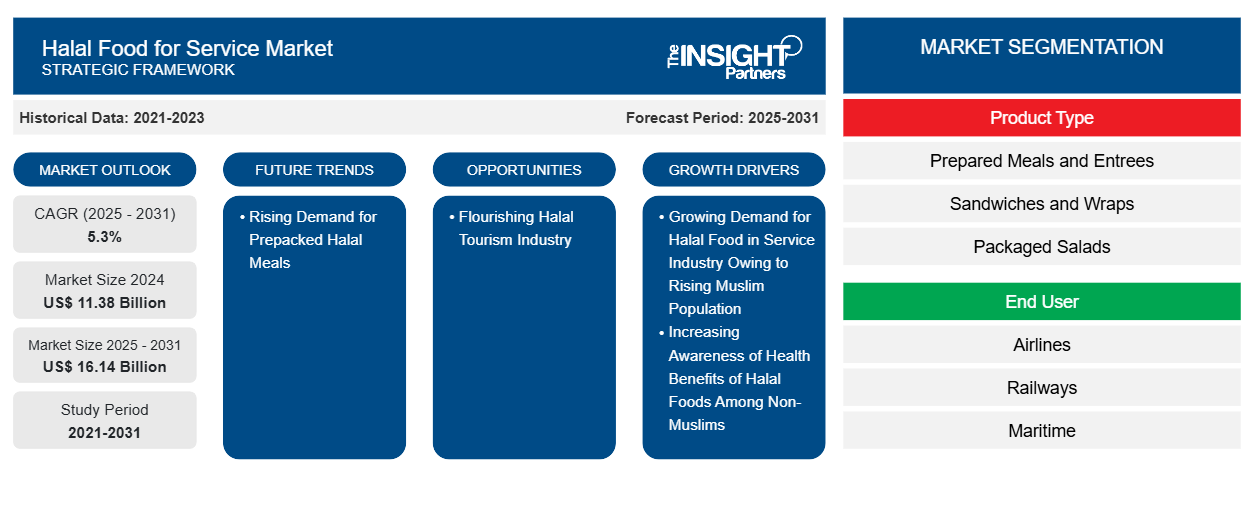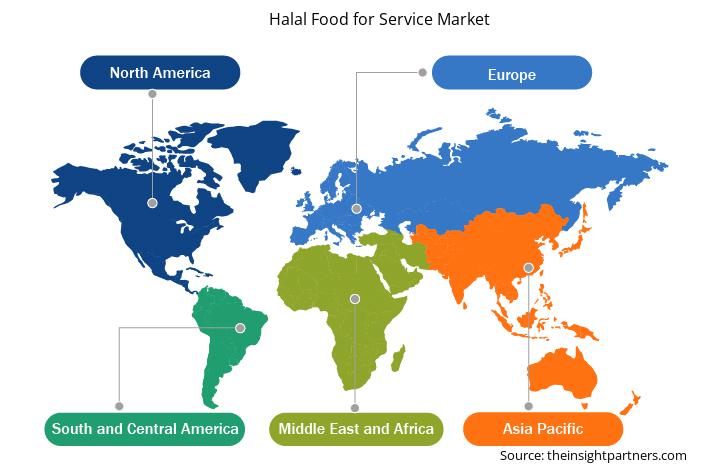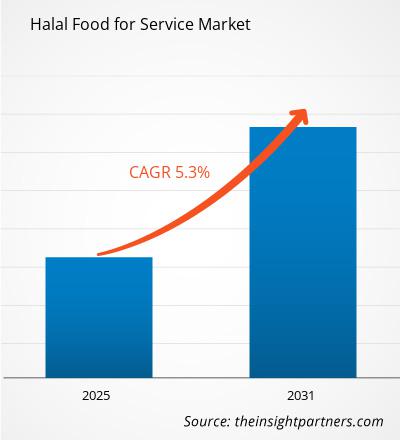预计到2031年,服务性清真食品市场规模将从2024年的113.8亿美元增至161.4亿美元。预计2025年至2031年期间,该市场的复合年增长率将达到5.3%。在预测期内,对预包装清真食品的需求不断增长,可能会为市场带来新的趋势。
清真食品服务市场分析
随着穆斯林人口激增、文化多元化趋势加剧以及非穆斯林对清真食品健康益处的认识不断提高,清真服务食品市场正在蓬勃发展。非穆斯林群体对清真食品的需求日益增长,这使得清真食品的吸引力超越了宗教界限。此外,随着穆斯林乘客航空出行数量的激增,各大航空公司纷纷在航班上提供清真餐食,以满足他们在旅途中的饮食偏好。穆斯林人口的不断增长也刺激了各机构、航空公司、铁路、海事部门和其他公共部门对清真餐食的需求。
清真食品服务市场概览
清真食品是指根据伊斯兰饮食法规制备和加工的食品,确保其适合穆斯林食用。这包括根据清真标准采购、处理和制备肉类、家禽和其他食品。清真食品在餐饮服务行业的应用日益广泛,包括餐厅、餐饮服务和机构食品供应商。清真食品以其清洁、符合道德标准的采购和注重健康的烹饪方式而闻名,吸引了穆斯林以外的广大消费者群体。随着消费者对清真认证、食品安全和道德食品采购意识的不断增强,服务业对清真食品的需求持续增长。消费者对经过认证且值得信赖的食品的日益青睐,推动了服务业清真食品市场的增长。
您可以免费定制任何报告,包括本报告的部分内容、国家级分析、Excel 数据包,以及为初创企业和大学提供优惠和折扣
清真食品服务市场:战略洞察

- 获取此报告的顶级关键市场趋势。此免费样品将包括数据分析,从市场趋势到估计和预测。
清真食品服务市场驱动力和机遇
提高非穆斯林对清真食品健康益处的认识
如今,消费者的健康意识日益增强,这影响了他们的食品消费偏好。消费者现在寻求能够保持健康并提高整体生活质量的膳食。清真认证被视为品质、纯度和新鲜度的标志。许多非穆斯林认为,获得清真认证的产品比未经认证的产品更安全、质量更高。由于获得清真认证的严格规定,清真食品已从一种宗教习俗演变为对安全、卫生和健康食品选择的保证。根据DinarStandard发布的《2021/2022年全球伊斯兰经济状况报告》,一些伊斯兰道德价值观在穆斯林群体之外也日益受到重视,非穆斯林消费者也更青睐清真肉类和清真产品。清真屠宰过程涉及彻底放血,从而降低微生物活性和污染风险。由于血液是细菌生长的媒介,因此去除血液可确保肉类更新鲜、更安全,保质期更长,并降低沙门氏菌等病原体的风险。清真肉类通常成分更精瘦,饱和脂肪含量更低,蛋白质含量更高,有助于肌肉发育、体重管理和心血管健康。清真肉类通常不含抗生素、激素和化学防腐剂,而这些成分在传统肉类中很常见。这种不含添加剂的食品符合消费者对低加工食品的需求,并减少了接触与抗生素耐药性和其他健康问题相关的物质。随着人们对清真肉类健康益处的认识不断提高,清真食品不仅与宗教习俗息息相关,也越来越受到非穆斯林群体的欢迎。
蓬勃发展的清真旅游产业
旅游业是全球最大的产业之一,它构建了文化纽带,促进了世界经济的进步。全球穆斯林游客数量的增加也带动了全球对清真食品的需求。这使得各国能够关注和推广清真旅游,以满足穆斯林乘客的饮食偏好。根据万事达卡新月评级,2022 年出国旅行的穆斯林人数为 1.1 亿,占国际入境总人数的 12%。据估计,到 2028 年,出国旅行的穆斯林人数将达到 2.3 亿,预计花费将达到 2250 亿美元。据同一来源称,这些穆斯林旅行者认为清真食品是最重要的因素,约 67% 的穆斯林在休闲旅行时优先考虑清真食品。为了满足日益增长的穆斯林旅客的需求,卡塔尔航空拥有约 3,000 名内部厨师,每天准备超过 200,000 份清真认证餐食。此外,马来西亚和印度尼西亚被认为是亚太地区首屈一指的清真旅游目的地。作为穆斯林占多数的国家,这些国家拥有完善的清真旅游基础设施,航空、铁路、海运、主题公园等渠道均提供清真食品。例如,马来西亚热门主题公园马来西亚乐高乐园表示,所有为穆斯林游客提供的食物均已获得马来西亚伊斯兰发展部的清真认证。此外,英国清真旅游局通过为各个服务行业的穆斯林游客提供清真食品,以满足他们的饮食需求,从而监督和推广英国的清真旅游。因此,全球蓬勃发展的清真旅游预计将为服务业清真食品市场带来增长机会。
清真食品服务市场报告细分分析
有助于得出清真食品服务市场分析的关键部分是产品类型和最终用户。
- 根据产品类型,市场细分为:熟食和主菜;三明治和卷饼;包装沙拉;开胃菜和小吃;汤、酱汁和调味品;甜点;以及其他。熟食和主菜在2024年占据了最大的市场份额。
- 就终端用户而言,市场细分为航空、铁路、海事、医疗保健、学校和学院、主题公园等。2024年,航空领域占据市场主导地位。
清真食品服务市场份额按地区分析
清真食品服务市场地理范围主要分为五个区域:北美、亚太、欧洲、中东和非洲、南美和中美。
2024 年,亚太地区占据了相当大的市场份额。由于文化多样性的增加和该地区穆斯林人口的庞大,亚太地区的清真食品服务市场正在蓬勃发展。根据《2023/2024 年全球伊斯兰经济状况 (SGIE) 报告》,全球穆斯林总人口的约 65% 生活在亚太地区,主要集中在印度尼西亚、巴基斯坦、印度和孟加拉国等国家。马来西亚和泰国的清真餐饮选择也拥有巨大的增长机会。随着这些国家消费者可支配收入的增加,各个行业选择清真餐饮而非非清真替代品的购买力也在增强。各种航空公司、铁路、海事、学校和学院以及各种娱乐中心都提供预先包装好的清真餐食和小吃,以满足这些国家日益增长的消费者需求。
印度和中国是该地区主要的清真食品服务市场。由于中国穆斯林人口众多,且对清真认证产品的需求不断增长,清真食品服务市场正在快速增长。宁夏、甘肃、青海和新疆是穆斯林人口众多的主要地区。这些地区拥有完善的清真认证体系和地方支持。此外,中国的铁路客流量不断增长,也刺激了对预包装和即食清真食品的需求。据《环球时报》报道,2024年前11个月,中国铁路旅客发送量创历史新高,达40.08亿人次,而2023年为38.6亿人次。
清真食品服务市场区域洞察
Insight Partners 的分析师已详尽阐述了预测期内影响清真服务食品市场的区域趋势和因素。本节还讨论了北美、欧洲、亚太地区、中东和非洲以及南美和中美洲的清真服务食品市场细分和地域分布。

- 获取清真食品服务市场的区域具体数据
清真食品服务市场报告范围
| 报告属性 | 细节 |
|---|---|
| 2024年的市场规模 | 113.8亿美元 |
| 2031年的市场规模 | 161.4亿美元 |
| 全球复合年增长率(2025-2031) | 5.3% |
| 史料 | 2021-2023 |
| 预测期 | 2025-2031 |
| 涵盖的领域 | 按产品类型
|
| 覆盖地区和国家 | 北美
|
| 市场领导者和主要公司简介 |
|
清真食品服务市场参与者密度:了解其对商业动态的影响
清真服务食品市场正在快速增长,这得益于终端用户需求的不断增长,而这些需求的驱动因素包括消费者偏好的不断变化、技术进步以及对产品益处的认知度不断提高。随着需求的增长,企业正在拓展产品线,不断创新以满足消费者需求,并抓住新兴趋势,从而进一步推动市场增长。
市场参与者密度是指特定市场或行业内企业或公司的分布情况。它表明特定市场空间内竞争对手(市场参与者)的数量相对于其规模或总市值而言。
在清真食品服务市场运营的主要公司有:
- 米达玛公司
- 清真美食
- 萝卜
- 法蒂玛·布兰德
- 清真食品公司
- LSG集团
免责声明:以上列出的公司没有按照任何特定顺序排列。

- 获取清真食品服务市场顶级关键参与者概览
清真食品服务市场新闻和最新发展
清真服务食品市场评估是通过收集一手资料和二手资料后进行的定性和定量数据进行的,这些数据包括重要的企业出版物、协会数据和数据库。清真服务食品市场近期的主要发展如下:
- Midamar,美国最受欢迎的清真品牌,自豪地庆祝其2024年成立50周年,并宣布其高端Zabiha清真牛肉干将回归。(来源:Midamar,简报,2024年6月)
- 印度航空决定不再向非穆斯林乘客提供清真肉类。目前,这些标有“穆斯林餐”的清真餐食将作为一项饮食偏好提供,并且仅向选择该餐食的乘客提供。(来源:印度航空,新闻稿,2024年5月)
清真食品服务市场报告覆盖范围和交付成果
《清真食品服务市场规模和预测(2021-2031)》报告对以下领域进行了详细的市场分析:
- 范围内涵盖的所有主要市场领域的全球、区域和国家层面的清真食品服务市场份额和预测
- 清真食品服务市场趋势,以及市场动态,如驱动因素、限制因素和关键机遇
- 详细的波特五力模型和 SWOT 分析
- 清真食品服务市场涵盖主要市场趋势、全球和区域框架、主要参与者、法规和最新市场发展
- 行业格局和竞争分析,涵盖市场集中度、热图分析、知名参与者以及清真食品服务市场的最新发展
- 详细的公司简介
- 历史分析(2 年)、基准年、预测(7 年)及复合年增长率
- PEST和SWOT分析
- 市场规模、价值/数量 - 全球、区域、国家
- 行业和竞争格局
- Excel 数据集
近期报告
客户评价
购买理由
- 明智的决策
- 了解市场动态
- 竞争分析
- 客户洞察
- 市场预测
- 风险规避
- 战略规划
- 投资论证
- 识别新兴市场
- 优化营销策略
- 提升运营效率
- 顺应监管趋势




















 获取免费样品 - 清真食品服务市场
获取免费样品 - 清真食品服务市场